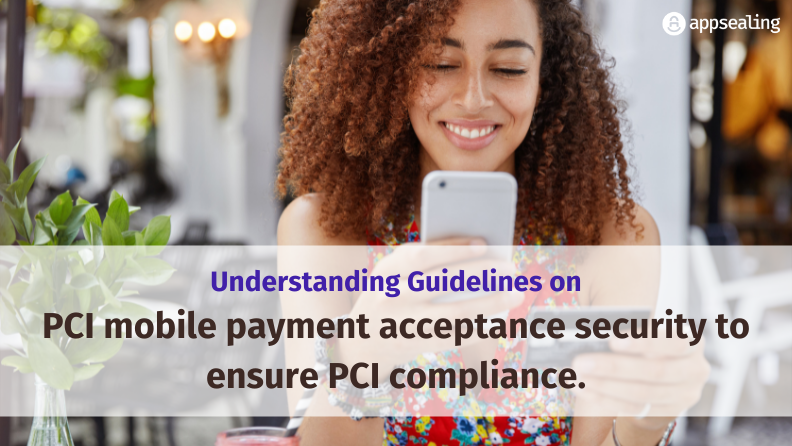Mobile applications have ensured convenience, ease, and swiftness. Transactions can happen with just the click of a button. But security issues also keep rearing their ugly heads every other minute. As new payment methods keep getting introduced in the market, newer challenges arise.
If your business works/depends on mobile applications that accept, process, store, or transmit payment card details, PCI (Payment Card Industry) compliance becomes paramount. Multiple cellular technologies like GSM, CDMA, GPS, and Bluetooth make it more challenging.
Security risks on mobile applications abound since mobile devices often have a broader set of functionalities when compared to their desktop and laptop counterparts. To be PCI Compliant, DevOps and DevSecOps teams should make sure to follow and meet some of the PCI Mobile Payment Acceptance Security Guidelines.
Key concepts of mobile application security and PCI Guidelines:
Companies are required to follow a set of guidelines and industry standards for protecting user data. Before we get into the details of these guidelines, let us look at the important concepts that help companies to be better prepared to deal with mobile application security:
- Tamper detection: This is real-time detection of any tampering that might be happening in a device. If not detected, this could compromise a device’s integrity or steal its data. When done right, this could help the device take appropriate actions.
- Root/Jailbreak detection: This detects attempts to exploit a device and install some illegal software. If not detected, an attacker can gain full access to the root of the operation system, files, and features.
- Hook detection: This detects if an outside application is illegally trying to intercept a called function residing in a system library or in one of the mobile applications.
- Debugger and decompiler detection: This checks for attempts where a user might want to view or change the running state of a program (debugger) or where a user might convert an executable program into an understandable format (decompiler) without the requisite permissions.
- Emulator detection: This checks for the presence of an emulator, which is usually used by attackers to reverse a code, attach a debugger, or attempt application tampering. An emulator, which enables one system to imitate the functions of another system, can thus be dealt with in a swift manner.
- Code encryption: This ensures that only authorized parties are able to get access to the code. The code is then decrypted by a secret key provided by the code owner/originator.
- Data and resource encryption: This ensures that data is translated into a different form so that it is not accessible or understandable by any third parties. Encrypted data is called ciphertext, which is then decrypted with a secret key on the other side by trusted parties. Digital data and resources are thus protected from unauthorized access.
PCI Mobile Payment Acceptance Security Guidelines
Now that we know the key aspects of ensuring mobile application security, let us look at some of the PCI guidelines.
4.1 Prevent unauthorized logical device access:
- Details: This guideline says that mobile devices should be protected against unauthorized access so that attackers cannot penetrate the systems.
- How AppSealing helps: AppSealing’s code encryption feature ensures that sensitive APIs and code are secure. It also proactively detects application tampering and detects jailbreak attempts.
4.2 Create server-side controls and report unauthorized access:
- Details: This guideline says that companies developing mobile applications should put in place checks to ensure prevention and reporting of any unauthorized access attempts. Companies should also be able to track abnormal activities and take corrective actions like discontinuing access in the future.
- How AppSealing helps: AppSealing’s robust mobile application security solution detects and reports unauthorized access to specific applications or functions
4.3 Prevent escalation of privileges:
- Details: This guideline says that companies should have relevant security measures in place to prevent the escalation of privileges. Bypassing permissions on devices could allow attackers to gain entry into a system or jailbreak it. Hardening helps here since it provides an additional layer of security to mobile applications.
- How AppSealing helps: AppSealing goes a step ahead and helps companies detect jailbreaking and rooting devices in both online and offline environments. The solution also provides a custom message to the user saying they have been blocked or that they do not have the requisite permissions to access the application.
4.7 Harden the applications:
- Details: This guideline says that mobile applications should be hardened end-to-end to prevent unauthorized access or attempts to break into a system. Code injection and reverse engineering attempts are also blocked.
- How AppSealing helps: AppSealing prevents code injection and reverse-engineering attacks while maintaining data integrity and code encryption. Through the power of Runtime Application Self Protection (RASP), the solution encrypts code not only at the file level but also at the memory level.
4.9 Conform to secure coding, engineering, and testing:
- Details: This guideline says that developers should follow best practices to draft secure codes. There should also be a formal response plan in case things go down south. Specifically, code tampering and reverse engineering need attention.
- How AppSealing helps: AppSealing’s RASP solution is the perfect solution to ensure the security of mobile applications right from the point of getting developed.
4.11 Protect the mobile device from unauthorized applications:
- Details: This guideline says that all authorized applications should permit authentication of the source and check for the integrity of executable files. The system should thus be able to detect and prevent unauthorized access attempts while also preventing the loading and execution of such applications.
- How AppSealing helps: AppSealing’s robust verification mechanism checks for the integrity of executables, files, and libraries. Tampering detection capabilities help further protect the application from attacks.
4.12 Protect the mobile device from malware:
- Details: This guideline states that mobile applications should have security software installed to look for malicious software or applications. In-app protection software and hardening solutions can also be implemented to detect and remove such malicious applications.
- How AppSealing helps: AppSealing ensures real-time scanning and protection of mobile applications to keep them away from attackers
4.13 Protect the mobile device from unauthorized attachments:
- Details: This guideline states that mobile applications should continuously check for outside attachments which could be trying to gain illegal entry into the system. Since mobile applications converse with each other, a scan for incoming files/attachments becomes important.
4.16 Provide an indication of a secure state:
- Details: This guideline states that mobile applications should be able to understand that they are operating in a secure state at any given point in time. The user should get the confidence that their data is safe and secure.
- How AppSealing helps: AppSealing’s round-the-clock security solution keeps giving regular updates about how safe and secure applications are as they keep interacting with the outside world and transacting on the go.
Conclusion
With AppSealing’s top-notch mobile application security, companies can monitor their mobile applications round-the-clock so that transactions and business interactions are all safeguarded, leading to a delightful and safe user experience.






